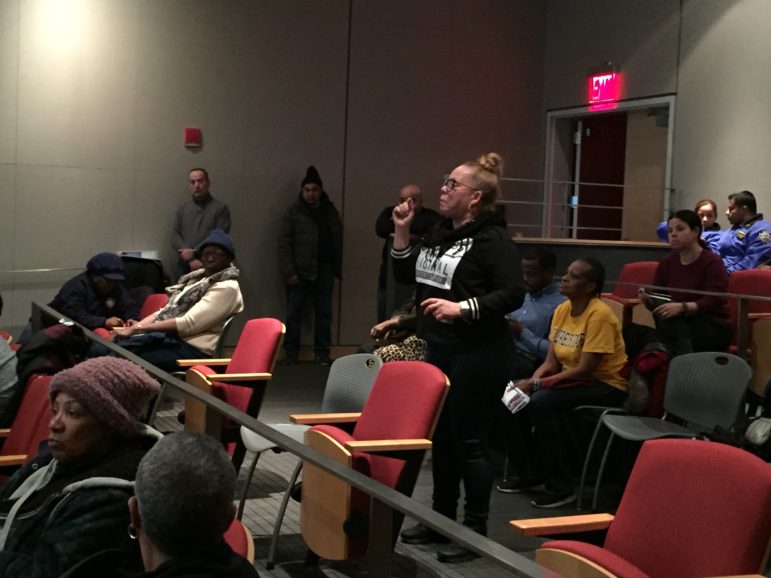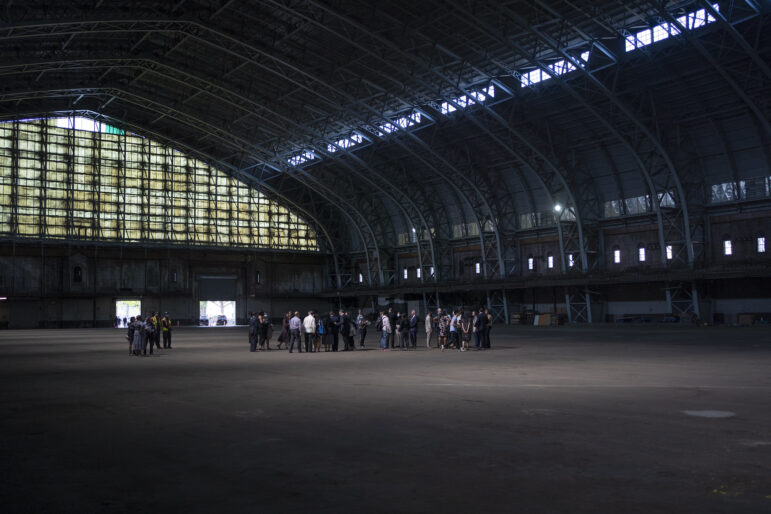
Abigail Savitch-Lew
NYCHA resident Carlita Thomas speaks about mold at Taft Houses at a NYCHA forum held on Wednesday night.
A night before Mayor de Blasio was to unveil the first budget of his second term, NYCHA residents and their allies made a plea for more funding than the mayor has pledged.
Dozens of developments across the city lost heat and hot water in January, including at East Harlem’s Taft Houses, where pipes froze for weeks.
That spurred the de Blasio administration on January 18 to commit $13 million to addressing the heating emergency. According to a press release, the funding will be used to hire 57 repair staff, rent three mobile boilers for emergency heating, repair and seal 9,600 windows, and, to prepare for next winter, purchase five new mobile boilers and replace and install boilers at five outer-borough developments.
On Wednesday, the mayor further announced that, as part of the preliminary budget he will release Thursday, he’d commit $200 million for long-term heating system upgrades at 20 different developments, including three—Taft, Rangel, and Robinson—in upper Manhattan.
On Wednesday evening, Harlem and East Harlem public housing residents, citywide and local elected officials, and advocates gathered to discuss steps forward for NYCHA after a winter of crisis. De Blasio was set to unveil his fiscal 2019 preliminary budget on Thursday afternoon.
Attendees at the forum, organized by local district leaders LaShawn Henry and Keith Lilly, generally agreed that this $200 million should only be the first of larger commitments to NYCHA made this year from the city, state, and the federal government.
While federal disinvestment in public housing over several decades is greatly to blame for NYCHA’s crisis, state and city disinvestment have also played a role, as pointed out by Victor Bach of the Community Service Society at the forum.
De Blasio has already broken with predecessors by making notable investments in NYCHA, including $300 million in heating and plumbing since 2014, $1.3 billion over 13 years for roof repair, another $555 million to repair brickwork over time, and by waiving payments to reduce $100 million a year in operating costs, according to a city press release.
Yet NYCHA has said that all heating repair upgrades will cost a total of $2 billion, and advocates say the city needs to do more.
“We are glad to see that Mayor de Blasio has increased his original stated investment of $13 million to $200 million for updated boilers. However, given the gravity of the city’s heating crisis, a more profound investment is needed. NYCHA has 326 developments, the mayor’s most recent investment will serve 20 developments – what will happen to the residents of the other 306?” wrote Afua Atta-Mensah, executive director of the East Harlem-based organization Community Voices Heard in a statement released earlier on Wednesday. She also called for a faster timeline for repairs.
Every five years, NYCHA completes a Physical Needs Assessment to determine the capital improvement needs across its aging portfolio. The 2011 PNA estimated the cost of the authority’s capital needs at $17 billion.
A December report by the Citizens Budget Commission released in December predicts that the 2017 PNA, which NYCHA plans to release soon, will include capital costs of over $25 billion.
At the forum, David Pristin, executive vice president of external affairs at NYCHA, said the exact figure was not yet available but that he agreed that NYCHA would likely have more than “$26 billion” in capital needs as a result of worsening deterioration and the growing costs of reconstruction.
Comptroller Scott Stringer emphasized the need for the city to come up with new revenue streams for NYCHA and plugged his idea to take $400 million a year from the Battery Park City Authority for NYCHA repairs. (De Blasio has so far refused to do so, saying those funds are needed for the creation of new affordable housing.) East Harlem Councilmember Diana Ayala said the council would also be pushing for additional NYCHA funding.
Making the case in Albany and Washington
Senator Brian Benjamin and Assemblymember Robert Rodriguez, who were also in attendance on Wednesday, said they planned to fight for $500 million for NYCHA in this year’s state budget. As earlier reported by City Limits, last year the state legislature approved $200 million for NYCHA (on top of a $100 million commitment made the year prior). Cuomo’s proposed budget for this year, however, includes no additional allocations for the authority.
Congressman Adriano Espaillat said he had convened representatives from other cities to discuss public housing with the goal of “position[ing] ourselves to ensure that public housing is considered nationally part of infrastructure.” He was referring to President Donald Trump’s State of the Union on Tuesday, in which Trump called for the creation of a $1.5 trillion infrastructure plan but did not explicitly mention housing as one of the things such a package could fund.
While NYCHA has faced chronic underfunding from the federal government for years, the authority faces new threats from the Trump administration, which has proposed a 68 percent cut ($220 million) to NYCHA’s capital budget and a 13 percent cut ($100 to $150 million) to NYCHA’s operating budget for the year 2018. Congress has still not approved a spending bill.
With nearly half a million residents, NYCHA should have more political clout, but some at the forum complained about a lack of participation by residents.
“You need to strengthen your tenant organizations…You’ve got [to get] more of your resident involved in your organization and you’ve got to make sure they’re informed about the threats to public housing,” suggested Bach in response to these complaints. His 2017 report on the authority argues that NYCHA residents bear tremendous potential for political power, but are inadequately organized.
Ayala noted that on lobbying trips to Washington, the buses aren’t always full. “We sometimes feel like somebody else is dealing with it, and that’s not necessarily the case,” she said.
Mixed views of management
This winter’s heating crisis followed shortly after the Department of Investigation revealed NYCHA had in 2016 falsely certified that it was in compliance with lead paint regulations. Just last Tuesday, the Department of Investigation once again faulted NYCHA Chair Shola Olatoye, this time for falsely telling the City Council this December that all NYCHA workers completing lead inspections for certain apartments in 2016 had been properly certified to do the work.
Public Advocate Letitia James and City Councilmember Ritchie Torres have both called for Olatoye’s resignation, while De Blasio has continued to stand by her side. The chairwoman wasn’t really the topic of discussion at the forum, and Stringer at one point said that the “challenge is to work with Shola and all the other stakeholders” to fix the heating problems as quickly as possible.
On the other hand, Borough President Gale Brewer heralded de Blasio’s appointment of Vito Mustaciuolo, a top official at the Department of Housing Preservation and Development, to become second in command at NYCHA as acting general manager. The current general manager, Michael Kelly, stepped down last week a day before the latest Department of Investigation exposure. “If anyone can pull off good management, it’s Vito Mustaciuolo,” Brewer said.
Many residents at the forum decried their living conditions and expressed concerns that their developments were closing work orders before repairs were actually completed. Brewer too said she was perplexed that it took so long for her office to get various issues addressed. “You got to have better pest control people!” she said to NYCHA at one point, though she also recognized NYCHA is “trying” to address its residents’ concerns.
Bach said he thought NYCHA ought to be monitored more like a private landlord. Ayala also spoke to the necessity of figuring out better ways to manage NYCHA problems. “There were a lot of things that we could have done differently,” she said, referring to the heating crisis at Taft Houses.
NYCHA’s Pristin tried to be diplomatic throughout the evening. “We apologize,” he said in his opening remarks. “I recognize that every single work order that we put in…there’s a person behind that. There’s hardship.”
He also blamed the heating challenges on lack of funding, the unusual cold spell in January, systemic problems with National Grid and Con Edison, and the simultaneous promotion of about 100 heating tech workers in the fall, which left the authority short staffed to address the crisis. He said that the authority is working on “quality management” to ensure repairs are completed well, is monitoring problematic buildings closely and looks forward to being more proactive in upgrading heating systems. “We can’t wait until something’s failing, like we have at Taft…We have to look at the next one’s that are going to happen and get in front of this,” he said.
But not everyone in the room was convinced.
“Excuse me. While all you are figuring this out, people are living in…unsafe conditions,” said one resident, who explained she’d been waiting for a plaster job for over a year. “It’s unhealthy for people to have to accept and live in these kind of conditions.”
Gentrification worries present
NYCHA is in some ways a fortress of protection against the pressures of the market: residents are required to pay no more than 30 percent of their income on rent. Yet that doesn’t mean that Harlem and East Harlem’s NYCHA residents are not also concerned about the impact of uptown’s rapid gentrification. As neighborhoods change, residents can be impacted by higher living costs and the loss of neighborhood culture. Residents or their children may also have a more difficult time remaining in the community if they try to move out of NYCHA. Whether NYCHA should be included as part of the mayor’s affordable housing plan—rather than subject to its own separate plan—is a continued matter of debate.
Stringer spoke directly to resident’s gentrification concerns—and those held by residents about the use of NYCHA land for private housing development. Developers “want to take over of the neighborhood you built. And I say to hell with them!” he said.
But Espaillat reminded NYCHA residents that they, as opposed to residents of the rent-stabilized housing stock in Washington Heights, are afforded more protections and are therefore able to build deep roots in their neighborhoods. “NYCHA is a community that brings stability to a neighborhood,” he said. “Gentrification…will not be able to take it down.”
Ayala noted that as part of the East Harlem rezoning approved in November by her predecessor, former Council Speaker Melissa Mark-Viverito, the district had secured $50 million from the administration for repairs in East Harlem NYCHA developments.
Some are concerned that the rezoning will spur the development of luxury housing, though a portion will be income-targeted under the city’s mandatory inclusionary housing policy.










One thought on “NYCHA Needs More than $200 Million, Say Residents and Advocates”
Pingback: NYCHA Needs More than $200 Million, Say Residents